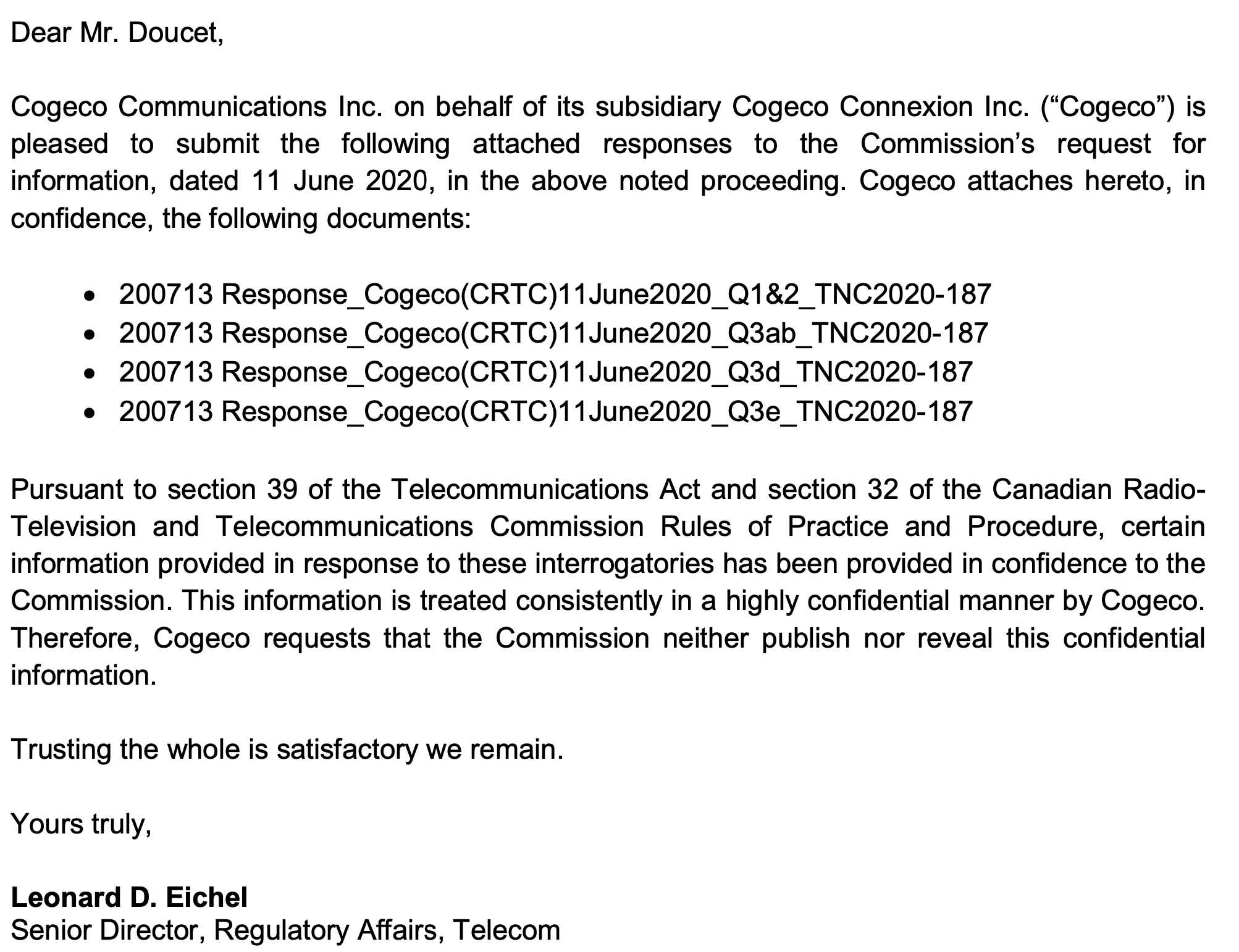This week I did something I have never had to do before - I filed an intervention with the CRTC on behalf of the Internet Society Canada Chapter (ISCC), saying that we could not make informed comment at this time because the incumbents filed virtually all information on the record to date in confidence and the CRTC has denied requisitions for disclosure of that information.
The proceeding in question is Telecom Notice of Consultation CRTC 2020-187, in which the CRTC sought input on the "the appropriate network and service configurations for the disaggregated wholesale HSA service regime". For those of you who are not avid followers of the CRTC, this proceeding is a continuation of the process started by CRTC back in 2015 (Policy 2015-326), which granted independent ISPs access to the fiber to the premises (FTTP) facilities of the incumbent carriers through a new disaggregated access model. This disaggregated access, in theory, would provide competitors with access to FTTP networks by building out interconnection points to the ILEC central office or a cable company head-end. At the time of the decision, it was viewed as a win for the independent ISPs. However, as with all things, the devil is often in the details.
Once you started to unwrap what it would take to implement the disaggregated access model, the more you began to realize it was a colossal mistake. Bell alone has 1016 central offices in Ontario and Quebec, 897 of which are currently capable of providing Internet services. That's 897 places an independent ISP would have to interconnect to Bell at to achieve full network coverage in Ontario and Quebec. Putting that into perspective, if a disaggregated HSA interconnection deployment was initiated at a Bell central office every two weeks with 30 deployments running simultaneously, it would take an independent ISP 43 years to deploy disaggregated HSA at each 1016 COs. Even if that calculation assumed an independent only having to deploy interconnections at the 897 place where internet is served today the math doesn't get any better.
There is no question that the matters under consideration in this proceeding will have significant impacts on Canada’s retail broadband service market. Whether if, and how, an appropriate configuration for disaggregated access can be created will have consequences for wholesale service providers, competitive ISPs, and, ultimately Canadian end-users. A properly structured disaggregated model should lead to greater competition and Canadians enjoying all the benefits of competitive choice when they shop for broadband services, including FTTP services. An improperly structured model will, at worst, eliminate the level of competitive choice available to Canadians today.
As an aside, the outdated thinking requiring providers to overbuild facilities based networks is flawed and access to FTTP should be provided on a fully aggregated basis - but that wasn't an option the CRTC presented for comment in this Notice so I'll leave my thoughts on that for another time.
Responding to these Notices of Consultation and other CRTC matters is something the ISCC excels at - we have a broad member base and a strong policy committee filled with smart people who have intelligent views on matters such as this. But when we reviewed the information on the record so far in response to questions that the CRTC asked the incumbents, we found that the incumbents' filed virtually all responses in confidence to the CRTC. Cogeco even filed all of its responses fully in confidence with the CRTC:

While it is standard for parties to claim confidence of information in CRTC proceedings, the number of claims made in this proceeding are unprecedented. CNOC, supported by others, filed a 36 page request to the CRTC setting out clear reasons and justifications as to why the CRTC should require information filed in confidence to be disclosed, to which the incumbents vehemently objected. They even cited national security concerns over the location of network equipment. The CRTC responded by requiring virtually nothing to be disclosed. Further, from reading that decision it is clear they did not even apply the appropriate framework to determine whether disclosure is in the public interest. The resulting level of disclosure is laughable. Below is a snapshot of extent of the information Rogers was required to disclose. Compared to its original filing, we now know the site name associated with the hashtags:

What are we, as an independent organization fighting for Canadians supposed to do in a situation like this? Comment on how confusing the Rogers site naming convention is? We know nothing about how the incumbent FTTB networks are deployed to even begin to comment on what network deployment models would make sense. In short, we can't answer the questions posed by the Commission because we don't possess the requisite information to form an informed opinion. In a democracy, citizens should have the right to participate, either directly or indirectly, in making the decisions that affect them, but apparently the CRTC doesn't think we should.
Private citizen involvement in CRTC processes has amazing value for Canadians - recall Ben Klass, a fellow board member at ISCC, who famously took on Bell Canada to fight for network neutrality and won. If he, as a private citizen, had not been allowed to participate in the process we all might not be reaping the rewards of his victory.
The CRTC needs to ensure that if it asks for Calls for Comment it ensures a process by which all can participate on an equal footing - anything less is a failure of our democratic process.
Comments